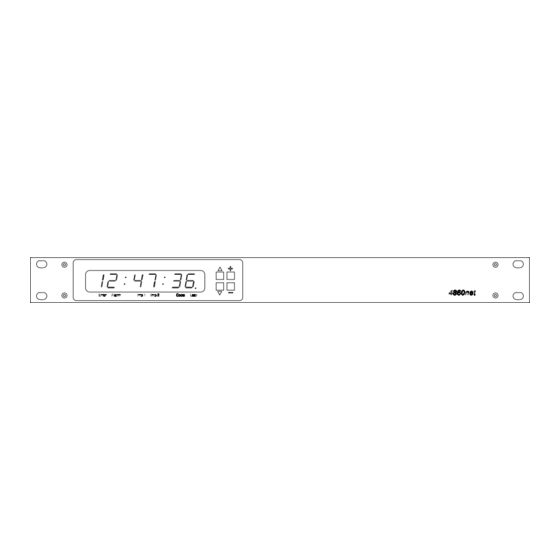
Summarization of Contents
Introduction to 4850/4860 Master Clock
Master Clock Features and Specifications
Details operational aspects, timing accuracy, interfaces, and connectivity options of the master clock.
Environmental and Physical Specifications
Details power supply, operating temperature range, and physical enclosure specifications.
4850/4860 Master Clock Programming
Manually Setting the Time and Date
Details manual time and date adjustment procedures via the front panel interface.
Leap Second Insertion Configuration
Explains how to enable and configure leap second adjustments for UTC accuracy.
System Setup Menu Options
Covers general configuration options and settings for the master clock.
Installation Guide
Power Supply Connection Instructions
Instructions for connecting the device to various AC and DC power sources.
External Connection Ports
Lists and describes the rear panel connection ports for interfaces and inputs.
Location Setup for Time Zones
Selecting Geographical Location
How to select a geographical location for accurate time zone and DST settings.
User Programmable Time Zone
For custom time offset and daylight saving change configurations.
Synchronisation Setup
GPS Synchronisation
Details using GPS satellites for highly accurate time synchronization.
GPS Receiver Installation
Specific installation steps for GPS receiver hardware (488HS/488B).
MSF and DCF Synchronisation
Explains using radio signals (MSF/DCF) for time synchronization.
MSF and DCF Receiver Installation
Guidelines for installing MSF/DCF radio receivers.
MSF and DCF Receiver Alignment
Procedures for aligning MSF/DCF receivers for optimal signal reception.
1 PPS / Serial ASCII Synchronisation
How to use pulse-per-second or serial ASCII data for synchronization.
w482 Time Zone Setup
w482 Setup Procedure
Steps to configure w482 time zone settings for slave clocks.
RS232 & RS485/485 Serial Output
Serial Output Operation
How the serial outputs function and transmit time data.
Setting the Serial Message Format
Selecting predefined or custom serial data formats for output.
Setting Output Message Time Offset
Referencing output messages to local or UTC time.
User Programmable Serial Settings
Configuring baud rate, data bits, parity, and stop bits.
Serial Setting Mode Navigation
Detailed menu navigation for configuring serial output parameters.
Relay Setup
Relay Output Operation
How the relay output functions and its capabilities.
Setting Programmable Relay Time
Configuring relay activation times and operational modes.
Network Configuration (4860net)
Network Quick Setup
Initial steps for configuring network settings on the 4860net.
4860net Operation as Time Server
How the 4860net functions as a Network Time Server.
TCP/IP Concepts Explained
Explanation of IP addresses, subnets, and gateways.
Supported Network Protocols
Overview of network time protocols like NTP and SNTP.
Network Setting Menu Navigation
Menu navigation for configuring IP, subnet, gateway, and NTP settings.
IRIG Output Configuration
IRIG Setup Options
Configuration of IRIG time code output formats.
Setting IRIG Signal Time Offset
Adjusting the IRIG signal reference to UTC or local time.
RS485 Level IRIG Output
Options for outputting IRIG signal via RS485 interface.
EBU Output Configuration
EBU Setup Options
Configuration of EBU timecode output formats.
Impulse Output Configuration
Impulse Output Commissioning
Initial procedures for setting up impulse clock systems.
Initial Setup Procedure for Impulse Clocks
Basic installation and initial clock setup for impulse systems.
Synchronisation of Impulse Clocks
Ensuring all slave clocks are synchronized together.
Programming Impulse Output Time
Setting the correct time for impulse outputs.
Starting Impulse Outputs
Activating the impulse output signals to drive slave clocks.
Visual Operation and Error Status
Interpreting LEDs for operational status and faults.
Appendix A: Cable Specifications
GPS Receiver Interconnection Cables
Cable requirements for GPS receiver connections (4850/4860 to 488HS/488BGPS).
MSF/DCF Receiver Interconnection Cables
Cable requirements for MSF/DCF receiver connections (4850/4860 to 484).
w482 Code Interconnection Cables
Cable specifications for the w482 time code system.
Analogue Impulse Clock Interconnection Cables
Cable specifications for impulse clock systems.
Appendix B: Case Dimensions
4850.R.x / 4860 Rackmount Dimensions
Physical dimensions for the 1U high rack-mount models.
4850.T.x Table-Top Dimensions
Physical dimensions for the table-top models.
Appendix C: Supported Devices
Supported VCRs and Digital Recorders
List of compatible VCRs and digital recorders for time synchronization.
Supported Matrix, Multiplexer, and CCTV Systems
List of compatible matrix, multiplexer, and CCTV systems.
Appendix D: NTP Synchronisation Option
NTP Client Quick Setup
Initial steps for configuring NTP synchronization on 4860netclient.
NTP Client Operation
How the 4860netclient synchronizes with an NTP time source.
NTP Synchronisation Status Display
Explains the status indicators for NTP synchronization.




Need help?
Do you have a question about the 4850 and is the answer not in the manual?
Questions and answers